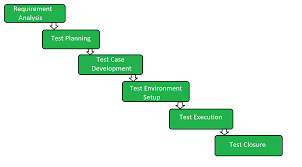Maximizing Quality Through Effective SDLC Testing Strategies
The Importance of Testing in Software Development Life Cycle (SDLC)
Software Development Life Cycle (SDLC) testing is a crucial phase in the development process that ensures the quality, functionality, and reliability of software applications. It involves various testing activities performed at different stages of the SDLC to detect and fix defects early, ultimately leading to a successful software product.
Types of Testing in SDLC
There are several types of testing carried out during different phases of the SDLC:
- Requirements Testing: Ensures that all requirements are clear, complete, and testable.
- System Testing: Validates the entire system’s functionality against specified requirements.
- Integration Testing: Checks if individual modules work together as expected.
- Unit Testing: Tests individual units or components of the software for proper functionality.
- User Acceptance Testing (UAT): Involves end-users testing the software to ensure it meets their needs.
The Benefits of SDLC Testing
Effective testing in SDLC offers numerous benefits:
- Early Defect Detection: Identifying and fixing defects early reduces costs and time required for rework later in the development cycle.
- Better Quality Software: Thorough testing leads to a higher-quality final product that meets user expectations.
- Risk Mitigation: Testing helps mitigate risks associated with software failures, security vulnerabilities, and performance issues.
- User Satisfaction: Ensuring that the software functions as intended increases user satisfaction and adoption rates.
In Conclusion
In conclusion, incorporating comprehensive testing into each phase of the Software Development Life Cycle is essential for delivering successful software projects. By investing time and resources into testing activities, organizations can achieve higher-quality products that meet user needs and expectations. SDLC testing plays a vital role in ensuring the success of software development initiatives.
5 Essential Tips for Effective SDLC Testing
- Start testing early in the SDLC to detect and fix issues sooner.
- Define clear testing objectives and requirements before starting testing.
- Utilize automation tools for repetitive and time-consuming test cases.
- Perform thorough regression testing after each code change or update.
- Involve stakeholders throughout the testing process to gather feedback and ensure alignment with expectations.
Start testing early in the SDLC to detect and fix issues sooner.
Starting testing early in the Software Development Life Cycle (SDLC) is a crucial tip to detect and address issues sooner rather than later. By incorporating testing from the initial stages of development, teams can identify defects early on, leading to cost-effective and efficient resolution. This proactive approach not only helps in improving software quality but also ensures that potential issues are tackled at their root, ultimately contributing to the successful delivery of a high-quality software product.
Define clear testing objectives and requirements before starting testing.
To ensure the effectiveness of testing in the Software Development Life Cycle (SDLC), it is crucial to define clear testing objectives and requirements before initiating the testing process. By establishing specific goals and criteria for testing, teams can focus their efforts on identifying and addressing potential issues early on, leading to a more efficient and successful software development cycle. Clear testing objectives help align stakeholders, prioritize testing activities, and ultimately contribute to delivering a high-quality software product that meets user expectations.
Utilize automation tools for repetitive and time-consuming test cases.
To enhance efficiency and accuracy in SDLC testing, it is advisable to leverage automation tools for repetitive and time-consuming test cases. By automating these tests, teams can save valuable time and resources while ensuring consistent execution of test scenarios. Automation tools not only accelerate the testing process but also help in detecting defects early, leading to improved software quality and faster time-to-market. Embracing automation in SDLC testing can streamline workflows, increase productivity, and enhance overall testing effectiveness.
Perform thorough regression testing after each code change or update.
Performing thorough regression testing after each code change or update is a critical tip in Software Development Life Cycle (SDLC) testing. Regression testing ensures that new code modifications do not adversely impact existing functionalities. By retesting the entire software system, including previously tested features, organizations can identify and fix any unintended consequences of the latest changes. This practice helps maintain the overall integrity and stability of the software application, ultimately leading to a more reliable and robust product.
Involve stakeholders throughout the testing process to gather feedback and ensure alignment with expectations.
In software development, it is crucial to involve stakeholders throughout the testing process to gather valuable feedback and ensure that the software aligns with their expectations. By engaging stakeholders from the early stages of testing, developers can gain insights into user requirements, preferences, and potential issues. This collaborative approach not only enhances communication and transparency but also increases the likelihood of delivering a product that meets stakeholders’ needs and satisfaction.




